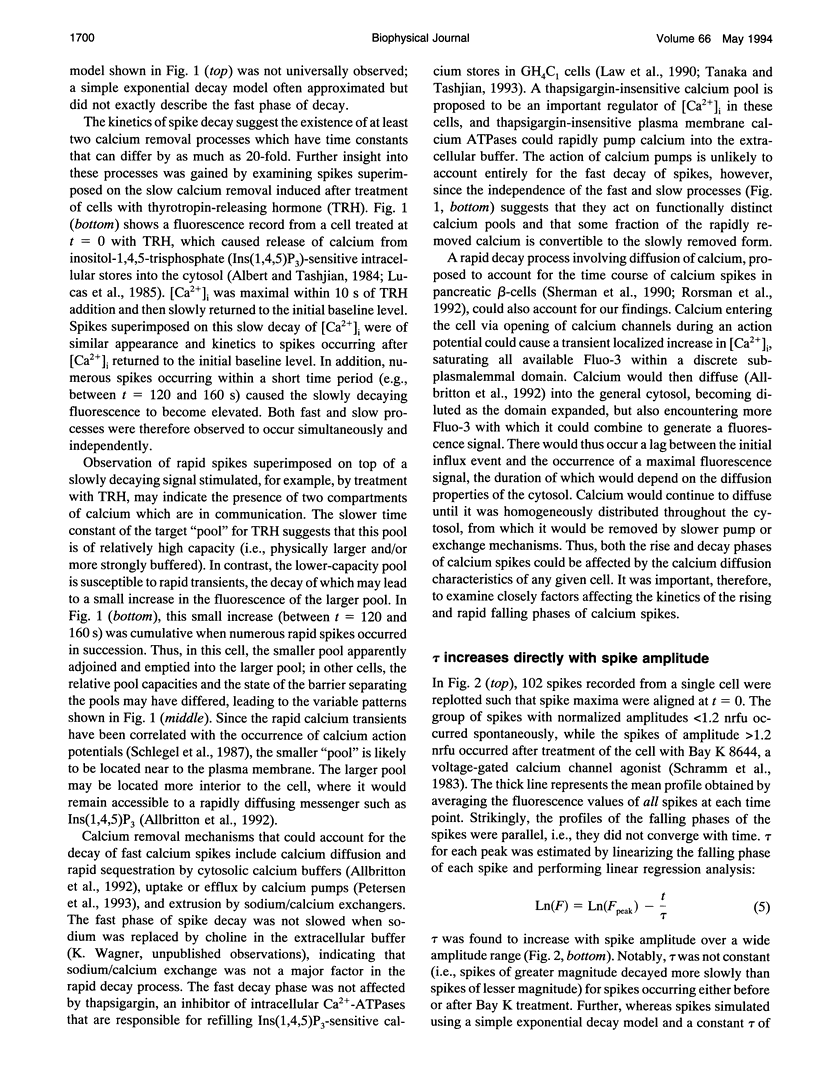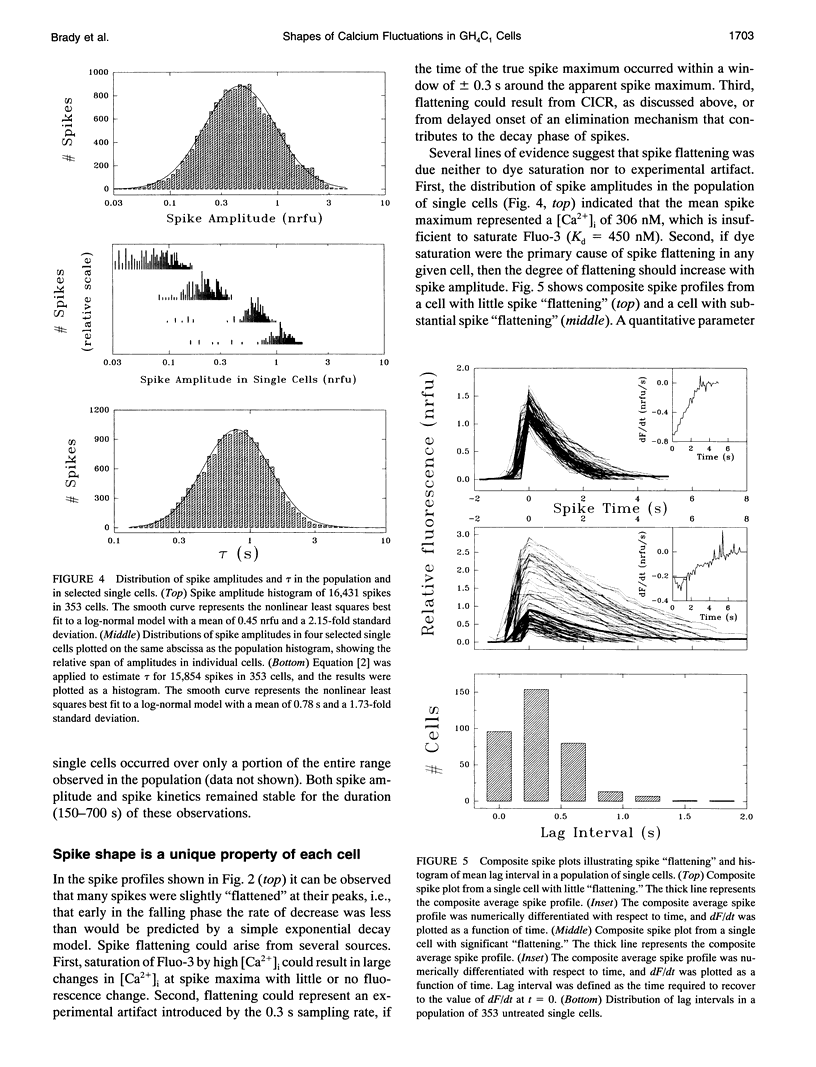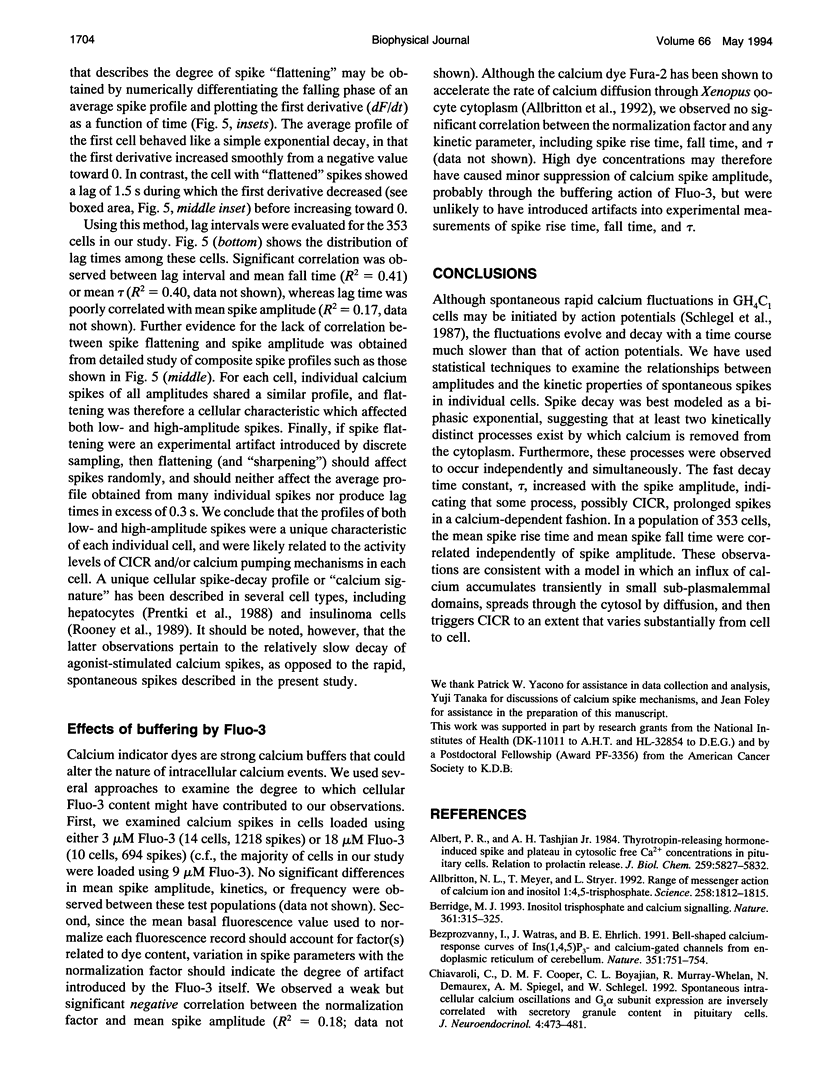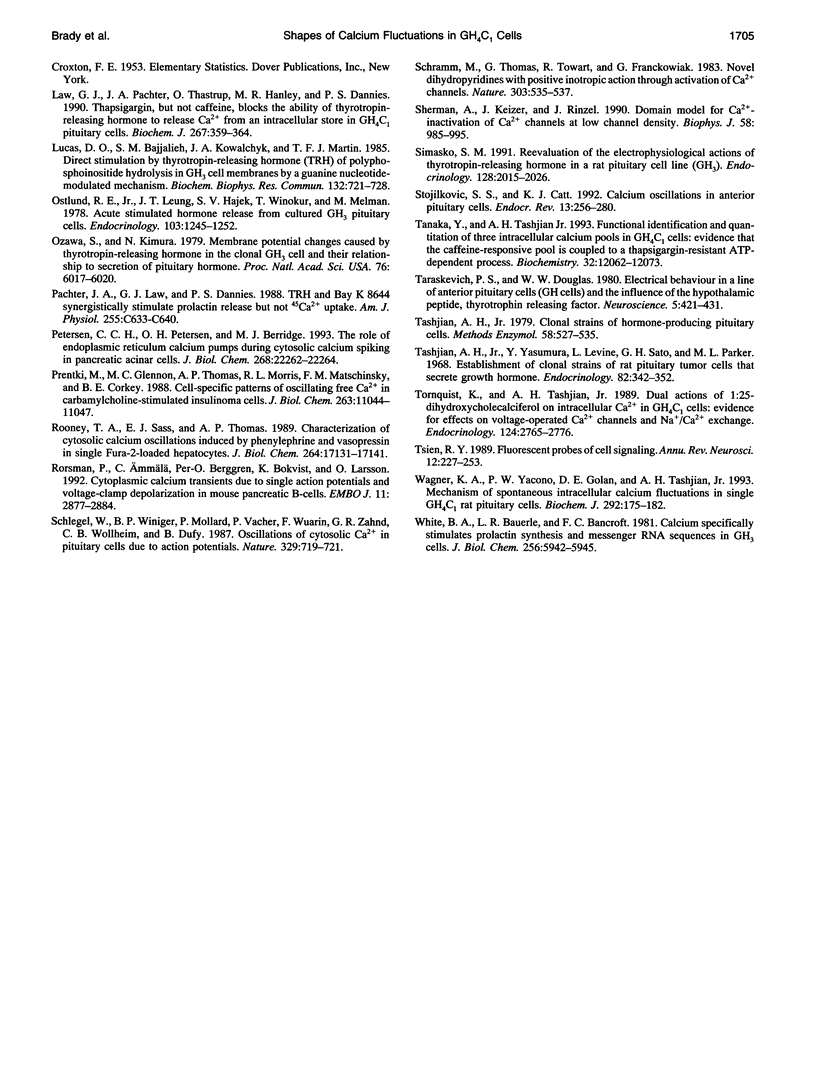Abstract
We have examined statistical relationships between the amplitudes and the kinetics (rise times, fall times, and decay constants) of cytosolic free calcium fluctuations (spikes) in a population of 353 individual GH4C1 rat pituitary cells. The fast falling phase was approximated by a single exponential decay, and the decay time constant, tau, increased linearly with spike amplitude in 80% of the cells studied. The slope of the tau versus amplitude plot for each cell was inversely related to the cell's mean spike amplitude. Thus, some process responsible for prolonging the decay phase of spikes appeared to operate strongly in cells with spikes of low amplitude, but to become less prominent in cells with high amplitude spikes. Mean tau correlated more strongly with mean rise and fall times than with mean spike amplitude, indicating that the kinetic properties of spikes were not tightly coupled to spike amplitude. These findings are consistent with a model wherein the rise phase corresponds to entry of extracellular calcium via L-type calcium channels into localized sub-plasmalemmal domains, followed by diffusion of subplasmalemmal calcium into the cell interior; and the falling phase corresponds to further calcium diffusion combined with activation of cytoplasmic calcium-induced calcium release, which prolongs the falling phase.
Full text
PDF








Selected References
These references are in PubMed. This may not be the complete list of references from this article.
- Albert P. R., Tashjian A. H., Jr Thyrotropin-releasing hormone-induced spike and plateau in cytosolic free Ca2+ concentrations in pituitary cells. Relation to prolactin release. J Biol Chem. 1984 May 10;259(9):5827–5832. [PubMed] [Google Scholar]
- Allbritton N. L., Meyer T., Stryer L. Range of messenger action of calcium ion and inositol 1,4,5-trisphosphate. Science. 1992 Dec 11;258(5089):1812–1815. doi: 10.1126/science.1465619. [DOI] [PubMed] [Google Scholar]
- Berridge M. J. Inositol trisphosphate and calcium signalling. Nature. 1993 Jan 28;361(6410):315–325. doi: 10.1038/361315a0. [DOI] [PubMed] [Google Scholar]
- Bezprozvanny I., Watras J., Ehrlich B. E. Bell-shaped calcium-response curves of Ins(1,4,5)P3- and calcium-gated channels from endoplasmic reticulum of cerebellum. Nature. 1991 Jun 27;351(6329):751–754. doi: 10.1038/351751a0. [DOI] [PubMed] [Google Scholar]
- Law G. J., Pachter J. A., Thastrup O., Hanley M. R., Dannies P. S. Thapsigargin, but not caffeine, blocks the ability of thyrotropin-releasing hormone to release Ca2+ from an intracellular store in GH4C1 pituitary cells. Biochem J. 1990 Apr 15;267(2):359–364. doi: 10.1042/bj2670359. [DOI] [PMC free article] [PubMed] [Google Scholar]
- Lucas D. O., Bajjalieh S. M., Kowalchyk J. A., Martin T. F. Direct stimulation by thyrotropin-releasing hormone (TRH) of polyphosphoinositide hydrolysis in GH3 cell membranes by a guanine nucleotide-modulated mechanism. Biochem Biophys Res Commun. 1985 Oct 30;132(2):721–728. doi: 10.1016/0006-291x(85)91192-1. [DOI] [PubMed] [Google Scholar]
- Ostlund R. E., Jr, Leung J. T., Hajek S. V., Winokur T., Melman M. Acute stimulated hormone release from cultured GH3 pituitary cells. Endocrinology. 1978 Oct;103(4):1245–1252. doi: 10.1210/endo-103-4-1245. [DOI] [PubMed] [Google Scholar]
- Ozawa S., Kimura N. Membrane potential changes caused by thyrotropin-releasing hormone in the clonal GH3 cell and their relationship to secretion of pituitary hormone. Proc Natl Acad Sci U S A. 1979 Nov;76(11):6017–6020. doi: 10.1073/pnas.76.11.6017. [DOI] [PMC free article] [PubMed] [Google Scholar]
- Pachter J. A., Law G. J., Dannies P. S. TRH and BAY K 8644 synergistically stimulate prolactin release but not 45Ca2+ uptake. Am J Physiol. 1988 Nov;255(5 Pt 1):C633–C640. doi: 10.1152/ajpcell.1988.255.5.C633. [DOI] [PubMed] [Google Scholar]
- Petersen C. C., Petersen O. H., Berridge M. J. The role of endoplasmic reticulum calcium pumps during cytosolic calcium spiking in pancreatic acinar cells. J Biol Chem. 1993 Oct 25;268(30):22262–22264. [PubMed] [Google Scholar]
- Prentki M., Glennon M. C., Thomas A. P., Morris R. L., Matschinsky F. M., Corkey B. E. Cell-specific patterns of oscillating free Ca2+ in carbamylcholine-stimulated insulinoma cells. J Biol Chem. 1988 Aug 15;263(23):11044–11047. [PubMed] [Google Scholar]
- Rooney T. A., Sass E. J., Thomas A. P. Characterization of cytosolic calcium oscillations induced by phenylephrine and vasopressin in single fura-2-loaded hepatocytes. J Biol Chem. 1989 Oct 15;264(29):17131–17141. [PubMed] [Google Scholar]
- Rorsman P., Ammälä C., Berggren P. O., Bokvist K., Larsson O. Cytoplasmic calcium transients due to single action potentials and voltage-clamp depolarizations in mouse pancreatic B-cells. EMBO J. 1992 Aug;11(8):2877–2884. doi: 10.1002/j.1460-2075.1992.tb05356.x. [DOI] [PMC free article] [PubMed] [Google Scholar]
- Schlegel W., Winiger B. P., Mollard P., Vacher P., Wuarin F., Zahnd G. R., Wollheim C. B., Dufy B. Oscillations of cytosolic Ca2+ in pituitary cells due to action potentials. Nature. 1987 Oct 22;329(6141):719–721. doi: 10.1038/329719a0. [DOI] [PubMed] [Google Scholar]
- Schramm M., Thomas G., Towart R., Franckowiak G. Novel dihydropyridines with positive inotropic action through activation of Ca2+ channels. Nature. 1983 Jun 9;303(5917):535–537. doi: 10.1038/303535a0. [DOI] [PubMed] [Google Scholar]
- Sherman A., Keizer J., Rinzel J. Domain model for Ca2(+)-inactivation of Ca2+ channels at low channel density. Biophys J. 1990 Oct;58(4):985–995. doi: 10.1016/S0006-3495(90)82443-7. [DOI] [PMC free article] [PubMed] [Google Scholar]
- Simasko S. M. Reevaluation of the electrophysiological actions of thyrotropin-releasing hormone in a rat pituitary cell line (GH3). Endocrinology. 1991 Apr;128(4):2015–2026. doi: 10.1210/endo-128-4-2015. [DOI] [PubMed] [Google Scholar]
- Stojilković S. S., Catt K. J. Calcium oscillations in anterior pituitary cells. Endocr Rev. 1992 May;13(2):256–280. doi: 10.1210/edrv-13-2-256. [DOI] [PubMed] [Google Scholar]
- Tanaka Y., Tashjian A. H., Jr Functional identification and quantitation of three intracellular calcium pools in GH4C1 cells: evidence that the caffeine-responsive pool is coupled to a thapsigargin-resistant, ATP-dependent process. Biochemistry. 1993 Nov 16;32(45):12062–12073. doi: 10.1021/bi00096a017. [DOI] [PubMed] [Google Scholar]
- Taraskevich P. S., Douglas W. W. Electrical behaviour in a line of anterior pituitary cells (GH cells) and the influence of the hypothalamic peptide, thyrotrophin releasing factor. Neuroscience. 1980;5(2):421–431. doi: 10.1016/0306-4522(80)90117-7. [DOI] [PubMed] [Google Scholar]
- Tashjian A. H., Jr Clonal strains of hormone-producing pituitary cells. Methods Enzymol. 1979;58:527–535. doi: 10.1016/s0076-6879(79)58167-1. [DOI] [PubMed] [Google Scholar]
- Tashjian A. H., Jr, Yasumura Y., Levine L., Sato G. H., Parker M. L. Establishment of clonal strains of rat pituitary tumor cells that secrete growth hormone. Endocrinology. 1968 Feb;82(2):342–352. doi: 10.1210/endo-82-2-342. [DOI] [PubMed] [Google Scholar]
- Tornquist K., Tashjian A. H., Jr Dual actions of 1,25-dihydroxycholecalciferol on intracellular Ca2+ in GH4C1 cells: evidence for effects on voltage-operated Ca2+ channels and Na+/Ca2+ exchange. Endocrinology. 1989 Jun;124(6):2765–2776. doi: 10.1210/endo-124-6-2765. [DOI] [PubMed] [Google Scholar]
- Tsien R. Y. Fluorescent probes of cell signaling. Annu Rev Neurosci. 1989;12:227–253. doi: 10.1146/annurev.ne.12.030189.001303. [DOI] [PubMed] [Google Scholar]
- Wagner K. A., Yacono P. W., Golan D. E., Tashjian A. H., Jr Mechanism of spontaneous intracellular calcium fluctuations in single GH4C1 rat pituitary cells. Biochem J. 1993 May 15;292(Pt 1):175–182. doi: 10.1042/bj2920175. [DOI] [PMC free article] [PubMed] [Google Scholar]
- White B. A., Bauerle L. R., Bancroft F. C. Calcium specifically stimulates prolactin synthesis and messenger RNA sequences in GH3 cells. J Biol Chem. 1981 Jun 25;256(12):5942–5945. [PubMed] [Google Scholar]


